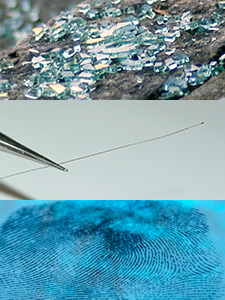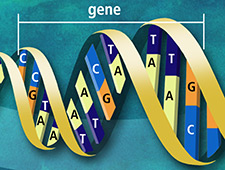Home | Glossary | Resources | Help | Contact Us | Course Map
Archival Notice
This is an archive page that is no longer being updated. It may contain outdated information and links may no longer function as originally intended.
Associative Evidence
Associative evidence originates from contact between
- people,
- objects,
- people and objects.
Associative evidence can be used to provide links between evidence and individuals involved in a crime. In some cases, the associative evidence (e.g., fingerprints or DNA) may be sufficient to prove the contact. In other cases, the associative evidence may be less definitive and provide corroboration of other evidence.
Examples of Associative Evidence
Examples of associative evidence include
- latent fingerprints left on an object,
- fibers left from contact of clothing with objects,
- blood from physical injury,
- semen from sexual assault,
- saliva from spitting, cigarettes, or envelopes,
- hair shed at a scene,
- paint transferred during a burglary or automobile accident,
- glass transferred during a burglary or from a bottle used as a weapon,
- soil from a scene,
- impressions from tools, footwear, or tire.
Value of Associative Evidence
The value of associative evidence depends on four factors:
- The specificity or degree of identity of the evidence
- The frequency of occurrence
- The persistence of the transferred material
- The likelihood of alternate explanations
Specificity
The value of associative evidence in regard to specificity or identity can be illustrated with a comparison of blood versus glass evidence.
Blood can be identified using DNA analysis. The typical DNA testing procedure results in the identification of the chemical composition at each of thirteen different locations on a DNA molecule. Every DNA molecule in the body of an individual will have the same composition at these sites. A reported DNA profile is therefore a specific description of a persons DNA.
In contrast, there are minute differences in the physical and trace chemical properties of a sheet of glass. Testing fragments from the glass sheet will reflect the variations in these properties; these variations will be greater in fragments originating in different locations across the same sheet of glass. The differences are small, but they do result in some uncertainty as to the absolute identity of the material tested and therefore the true value of the associative evidence.
Frequency of Occurrence
The significance of associative evidence also depends on the frequency of occurrence of the measured attribute in the environment.
For example, the frequency in various human populations (Caucasian, Negroid, Mongoloid, etc.) of the DNA composition at each of the thirteen locations (known as the thirteen core loci) has been measured. The frequency of the full profile in the population as a whole can therefore be calculated. The accepted process for doing this and deriving a numerical description of the rarity of the DNA profile is complex, but, in essence, a DNA profile from the thirteen core loci is unique (other than for identical twins).
In contrast to the biological diversity between individuals, the tight quality control of the manufacturing of glass would lead us to expect a high degree of similarity in the physical and chemical properties of glass produced in a single batch. However, batch-to-batch variation and the small within-batch differences referred to previously mean that it has not been possible to establish population databases for glass that are as useful as those for DNA.
| Most Common Allele Frequencies in the FBI Caucasian Database | ||
| STR Marker |
# of Alleles |
Random Match Probability (FBI Caucasian) |
| CSF1PO | 11 | 0.112 |
| FGA | 19 | 0.039 |
| TH01 | 7 | 0.081 |
| TPOX | 7 | 0.195 |
| VWA | 10 | 0.062 |
| D3S1358 | 10 | 0.075 |
| D5S818 | 10 | 0.158 |
| D7S820 | 11 | 0.065 |
| D8S1179 | 10 | 0.067 |
| D13S317 | 8 | 0.085 |
| D16S539 | 8 | 0.089 |
| D18S51 | 15 | 0.028 |
| D21S11 | 20 | 0.039 |
| Product | 0.000000000000001683 | |
| One in | 594,059,679,247,540 | |
| 1 in 594 trillion | ||
Persistence
Some associative evidence, such as latent prints and biological fluids, can be detected for a considerable time after deposition. Other types of evidence, such as hairs, glass, and fibers, are transferred to the receiving object and are shed over a relatively short period of time. The main issue to bear in mind is that no conclusion can be drawn from the absence of detected associative evidence targets.
Alternate Explanations
The question may be posed as Could it be that my DNA matches the target profile by chance? and the known population frequencies can be used to provide the answer.
Other alternate explanation scenarios are more difficult to deal with, for example:
- Semen resulting from intercourse by consent, in contrast to rape
- Blood transferred in the course of giving assistance to an injured person
- A fingerprint deposited innocently at the location some time prior to the crime
Additional Online Courses
- What Every First Responding Officer Should Know About DNA Evidence
- Collecting DNA Evidence at Property Crime Scenes
- DNA – A Prosecutor’s Practice Notebook
- Crime Scene and DNA Basics
- Laboratory Safety Programs
- DNA Amplification
- Population Genetics and Statistics
- Non-STR DNA Markers: SNPs, Y-STRs, LCN and mtDNA
- Firearms Examiner Training
- Forensic DNA Education for Law Enforcement Decisionmakers
- What Every Investigator and Evidence Technician Should Know About DNA Evidence
- Principles of Forensic DNA for Officers of the Court
- Law 101: Legal Guide for the Forensic Expert
- Laboratory Orientation and Testing of Body Fluids and Tissues
- DNA Extraction and Quantitation
- STR Data Analysis and Interpretation
- Communication Skills, Report Writing, and Courtroom Testimony
- Español for Law Enforcement
- Amplified DNA Product Separation for Forensic Analysts



